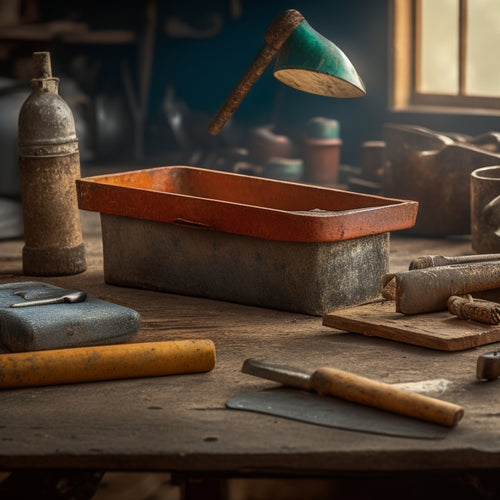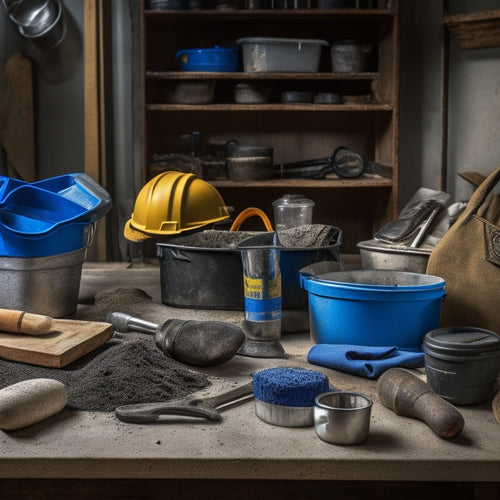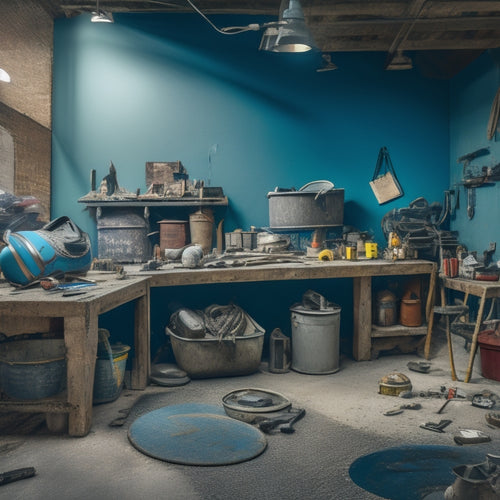
Selecting the Right Tools for Concrete Block Foundations
Share
When building concrete block foundations, you'll need a well-curated set of tools to guarantee accurate and efficient work. Start by selecting essential hand tools that prioritize durability, ergonomics, and rust-resistance. Measuring and marking tools, like tape measures and chalk lines, guarantee precise layout and block placement. Trowels, hammers, and chisels are must-haves for mortar application, block shaping, and cutting. Reliable levels detect deviations from horizontal and vertical planes, while specialized tools like diamond-blade saws and hammer drills aid in cutting and drilling. With the right tools, you'll reduce project errors and rework, and now, you're ready to explore the finer details of selecting the perfect toolkit for your concrete block foundation project.
Key Takeaways
• Essential hand tools, such as trowels, hammers, and chisels, ensure accurate and efficient work for concrete block foundations.
• Measuring and marking tools, like tape measures and levels, guarantee precise measurements for square, level, and plumb foundations.
• Specialized tools, including diamond-blade saws and hammer drills, are necessary for cutting, drilling, and mixing concrete materials.
• Safety gear, such as protective eyewear and gloves, is crucial for safeguarding against masonry hazards and ensuring a safe working environment.
• Proper tool selection and maintenance enhance efficiency, accuracy, and longevity in concrete block projects, reducing time and labor costs.
Essential Hand Tools for Masonry
You'll frequently need a set of essential hand tools for masonry to guarantee accurate and efficient work when building a concrete block foundation. These tools will help you achieve professional results and secure your project's success.
When selecting hand tools, consider the type of masonry work you'll be doing, the frequency of use, and the level of precision required. Tool selection tips include choosing tools with durable materials, ergonomic handles, and rust-resistant coatings.
It's also vital to prioritize masonry tool maintenance to extend their lifespan and prevent damage. Regularly clean and lubricate your tools, store them in a dry place, and perform routine inspections for wear and tear.
Trowels for Concrete Block Laying
With hand tools in place, it's time to focus on the specialized tools required for concrete block laying, starting with the trowel, an essential instrument for applying and shaping mortar.
As you prepare to lay concrete blocks, you'll need a reliable trowel that can handle the demands of the job. There are different trowel types to take into account, including point trowels, notched trowels, and V-notched trowels, each with its own unique features and benefits.
When selecting a trowel, keep in mind the following key factors:
-
Trowel size: Choose a trowel that's suitable for the size of your blocks and the mortar joints.
-
Trowel material: Opt for a trowel made from durable materials, such as stainless steel or high-carbon steel, to guarantee longevity.
-
Trowel handle: Select a trowel with a comfortable, ergonomic handle that provides a secure grip.
Proper trowel maintenance is also vital to extend its lifespan. Regularly clean and dry your trowel to prevent rust and corrosion.
Levels for Accurate Foundation Building
Accurate foundation building relies heavily on verifying the blocks are perfectly level, which is where a reliable level comes into play. This tool allows you to detect even the slightest deviations from the horizontal or vertical planes. A level guarantees that your foundation is built on a solid, stable base, which is vital for the structural integrity of the entire building.
With a level, you can employ various leveling techniques to assure that your blocks are aligned correctly, preventing any potential issues with foundation stability.
When choosing a level, consider the type of project you're working on and the level of precision required. For instance, a digital level may be more suitable for larger projects that demand high accuracy, while a traditional spirit level may suffice for smaller, less complex tasks.
Additionally, look for levels with adjustable vials, which enable you to fine-tune your measurements. By investing in a reliable level, you'll be able to verify that your foundation is built to last, providing a solid base for your structure to stand tall.
Hammers for Block Shaping and Breaking
When shaping and breaking concrete blocks, you'll need a reliable hammer that can handle the task.
You'll use it to chisel the block face, removing excess material to create a precise fit, and to break edges to achieve the desired shape.
For these tasks, you'll want to select a hammer that provides the right balance of force and control.
Block Face Chiseling
You'll need a reliable hammer for block face chiseling, an essential step in shaping and breaking concrete blocks to fit your foundation's design specifications. This process involves removing excess material from the block surface to guarantee a snug fit and proper alignment.
To achieve this, you'll need to master the art of block face chiseling, which requires precision, patience, and the right tools.
When selecting a hammer for block face chiseling, consider the following key factors:
-
Weight and balance: A hammer that's too heavy can be cumbersome, while one that's too light may not provide enough force.
-
Handle material and grip: A comfortable, non-slip grip is vital for maintaining control and reducing fatigue.
-
Head shape and size: A hammer with a flat, broad head is ideal for block face chiseling, as it allows for more efficient material removal.
Proper block surface preparation is essential for successful block face chiseling. Make sure to clean and inspect the block surface before chiseling, and maintain your chisels using proper maintenance techniques to guarantee peak performance.
Edge Breaking Techniques
To shape and break concrete blocks, edge breaking techniques require hammers specifically designed for this purpose, featuring unique characteristics that enable efficient and precise block manipulation.
These hammers typically have a wedge-shaped head, which allows you to target specific areas of the block for breaking or shaping. When selecting a hammer for edge breaking, consider the weight and balance of the tool, as well as the material it's constructed from. A hammer with a durable handle and a heavy, dense head will provide more force and control.
When using edge breaking techniques, it's crucial to follow proper edge preparation methods to guarantee a clean, precise break. This includes scoring the block along the desired break line and applying gentle, controlled taps to the hammer.
Additionally, surface finishing techniques, such as grinding or sanding, may be necessary to smooth out the broken edge. By mastering edge breaking techniques and selecting the right hammer for the job, you'll be able to achieve professional-looking results and take your concrete block foundation project to the next level.
Chisels for Cutting and Removing
Selecting the right chisel for cutting and removing concrete block is crucial, as it enables you to make precise cuts and dismantle existing structures efficiently. With the right chisel, you'll be able to make clean cuts, reduce waste, and work more efficiently.
When choosing a chisel, consider the type of concrete block you're working with, as well as the cutting technique you'll be using.
There are several types of chisels to choose from, each suited for specific tasks:
-
Point chisels for breaking up and removing small areas of concrete
-
Flat chisels for making straight cuts and removing larger sections of concrete
-
Claw chisels for prying and removing concrete blocks intact
When it comes to cutting techniques, it's crucial to use the right chisel for the job. For example, using a point chisel with a hammer and chisel technique can be effective for breaking up small areas of concrete, while a flat chisel with a sawing motion can be used for making straight cuts.
Safety Gear for Masonry Work
Wearing the right safety gear is essential for protecting yourself from the hazards inherent in masonry work, including flying debris, dust, and heavy materials. You'll need protective gear that covers your eyes, hands, and body to guarantee your safety while working with concrete blocks.
Here's a rundown of the essential safety gear you'll need:
| Safety Gear | Purpose | Features |
|---|---|---|
| Protective Eyewear | Protect eyes from flying debris and dust | Anti-fog lenses, scratch-resistant |
| Safety Gloves | Protect hands from cuts, abrasions, and crush injuries | Reinforced palms, grip patterns |
| Dust Mask | Protect lungs from inhaling dust and debris | Filtered air, adjustable straps |
Measuring and Marking Tools Needed
You'll need a set of measuring and marking tools to accurately layout and construct your concrete block foundation, making sure your project meets specifications and building codes. These tools will help you achieve precise measurements, making certain your foundation is square, level, and plumb.
To guarantee marking accuracy, you'll need:
-
A high-quality tape measure or laser distance meter for precise length measurements
-
A combination square or protractor to guarantee accurate 90-degree angles
-
A chalk line or spirit level to mark straight lines and level surfaces
Mastering various measuring techniques is vital for achieving marking accuracy. For instance, you can use the 'story pole' method to transfer measurements from the blueprint to the construction site.
Additionally, understanding how to read and interpret measurement marks will help you avoid errors and ensure your foundation is built to last.
Specialized Tools for Specific Tasks
Beyond measuring and marking, your concrete block foundation project requires specialized tools for specific tasks, such as cutting, drilling, and mixing, to guarantee efficient and accurate completion of each stage. You'll need tools that can handle the demands of working with concrete blocks, ensuring precise block alignment and proper mortar mixing.
When it comes to cutting, you'll need a diamond-blade saw or a masonry saw to make clean cuts through the blocks. For drilling, a hammer drill or rotary hammer is essential for creating holes for anchor bolts and other fixtures. Mixing mortar requires a mixing bucket or a powered mixer, while a pointing trowel and a level are necessary for ensuring the blocks are properly aligned.
Here are some specialized tools you'll need for your concrete block foundation project:
| Tool | Purpose |
|---|---|
| Diamond-blade saw | Cutting concrete blocks |
| Hammer drill | Drilling holes for anchor bolts |
| Mixing bucket | Mixing mortar |
| Pointing trowel | Applying and smoothing mortar |
| Level | Ensuring block alignment |
Frequently Asked Questions
Can I Use a Regular Drill for Mixing Concrete?
You can't use a regular drill for mixing concrete; it's not designed for heavy-duty mixing. Instead, invest in a drill specifically designed for mixing, like a paddle mixer or a concrete drill, which can handle thick mixtures and various mixing techniques.
How Often Should I Clean and Maintain My Masonry Tools?
You might think maintenance is a hassle, but trust us, it's essential! Clean your masonry tools daily, and perform in-depth maintenance every 1-2 weeks to guarantee peak performance, extend their lifespan, and maintain your independence.
Are There Any Eco-Friendly Alternatives to Traditional Masonry Materials?
You're looking for eco-friendly alternatives to traditional masonry materials, and you'll be pleased to know that sustainable materials and recycled aggregates are becoming increasingly popular, offering a greener, more environmentally conscious choice for your projects.
Can I Use Concrete Blocks for Above-Ground Construction Projects?
You can use concrete blocks for above-ground construction projects, but make certain you choose blocks with sufficient strength to support the structure's weight, as block strength directly impacts construction stability, ultimately assuring your project's freedom from structural issues.
What Is the Ideal Temperature for Laying Concrete Blocks Outdoors?
'You're not trying to lay concrete blocks in the scorching heat of a thousand suns! For ideal weather, aim for temperatures between 40°F and 90°F (4°C and 32°C) to guarantee proper curing, as extreme temperatures can greatly impact the blocks' strength and durability.'
Conclusion
You've got the right tools, but you might be thinking, 'Do I really need all these specialized tools for a concrete block foundation?'
The answer is yes. While it may seem like an upfront investment, having the right tools guarantees accuracy, efficiency, and safety on the job site.
Without them, you risk costly mistakes, injuries, and a compromised foundation.
Invest in the tools, and you'll be building a strong foundation that will last for years to come.
Related Posts
-

Smart Guide to Buying Used Concrete Hand Tools
You're about to buy used concrete hand tools, and you need to get it right. Dedicate time to identify the tools you n...
-

5 Tools Needed for Quick Fix Concrete Mixing
You'll need five essential tools to tackle a quick fix concrete mixing project efficiently. First, you'll require a s...
-

What Tools Do You Need for Concrete Flooring
You'll need a thorough arsenal of specialized tools to achieve a high-quality, professional-looking concrete floor, i...


